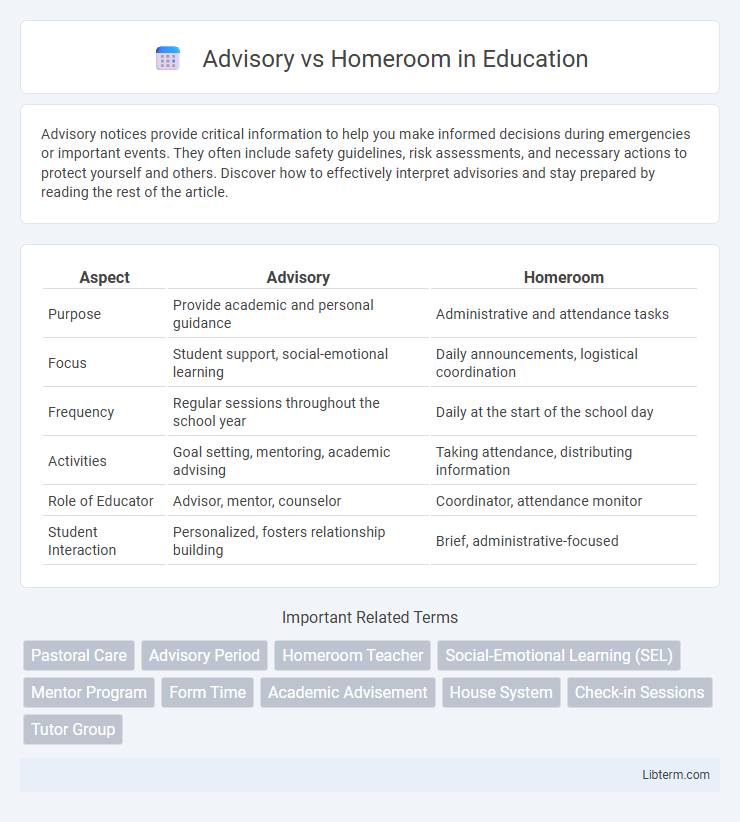Advisory notices provide critical information to help you make informed decisions during emergencies or important events. They often include safety guidelines, risk assessments, and necessary actions to protect yourself and others. Discover how to effectively interpret advisories and stay prepared by reading the rest of the article.
Table of Comparison
| Aspect | Advisory | Homeroom |
|---|---|---|
| Purpose | Provide academic and personal guidance | Administrative and attendance tasks |
| Focus | Student support, social-emotional learning | Daily announcements, logistical coordination |
| Frequency | Regular sessions throughout the school year | Daily at the start of the school day |
| Activities | Goal setting, mentoring, academic advising | Taking attendance, distributing information |
| Role of Educator | Advisor, mentor, counselor | Coordinator, attendance monitor |
| Student Interaction | Personalized, fosters relationship building | Brief, administrative-focused |
Understanding Advisory and Homeroom: Core Differences
Advisory typically centers on personalized student support, fostering academic growth, social-emotional development, and individual goal-setting through regular, small-group meetings. Homeroom functions as a daily administrative hub where attendance is taken, announcements are made, and logistical information is conveyed to students. Understanding their core differences clarifies that advisory prioritizes mentorship and holistic development, whereas homeroom focuses on organization and communication within the school day.
Purpose and Objectives of Advisory Programs
Advisory programs aim to foster student-teacher relationships, promote personal growth, and support academic success through regular, personalized guidance. These programs focus on developing social-emotional skills, enhancing decision-making, and providing a consistent support system to address individual student needs. Unlike homeroom, which primarily serves administrative functions like attendance and announcements, advisory centers on holistic development and mentorship.
The Role of Homeroom in School Structure
Homeroom serves as the foundational organizational unit in school structures, providing a consistent space for attendance, announcements, and fostering student-teacher relationships. Unlike advisory programs that focus on personalized guidance and social-emotional learning, homerooms primarily facilitate administrative functions and community building within the broader school environment. This structured setting supports efficient communication while promoting a stable, routine framework essential for student engagement and school cohesion.
Social-Emotional Learning in Advisory vs Homeroom
Advisory programs prioritize Social-Emotional Learning (SEL) by providing dedicated time for students to develop self-awareness, emotional regulation, and interpersonal skills through structured activities and discussions. Homeroom periods often serve administrative purposes, such as attendance and announcements, offering limited SEL engagement. Effective advisories create a supportive environment that fosters relationship-building, resilience, and empathy, contributing significantly to students' social and emotional growth.
Academic Support: Advisory vs Homeroom Functions
Advisory focuses on personalized academic support, providing students with tailored guidance on course selection, study habits, and goal-setting to enhance their learning experience. Homeroom primarily serves as an administrative hub for attendance and announcements, with limited direct involvement in individualized academic progress. Effective academic support is thus more robust in advisory sessions, where educators actively monitor and assist students' educational development.
Building Relationships: Advisory or Homeroom?
Advisory sessions foster deeper, personalized relationships between students and advisors by emphasizing consistent, small-group interaction and emotional support. Homerooms often serve administrative functions such as attendance and announcements, limiting opportunities for meaningful relationship-building. Prioritizing advisory structures enhances student engagement, trust, and academic success through targeted mentorship.
Implementation Strategies for Advisory and Homeroom
Effective implementation of advisory programs involves structured mentor-student relationships fostering personalized academic and social support, with regular meetings tailored to student needs. Homeroom implementation strategies emphasize daily administrative tasks, attendance tracking, and brief community-building activities to create a consistent, welcoming environment. Combining advisory and homeroom approaches can enhance student engagement by balancing emotional support with routine organizational functions.
Student Engagement in Advisory Compared to Homeroom
Advisory sessions are designed to foster stronger student engagement by promoting interactive discussions, personalized support, and goal-setting activities, unlike traditional homeroom periods that primarily handle administrative tasks. Research indicates students participating in advisory programs report higher motivation, improved social connections, and enhanced academic self-regulation. Schools emphasizing advisory structures often achieve better student attendance and behavior outcomes compared to institutions that maintain a standard homeroom model.
Teacher Responsibilities: Advisory vs Homeroom
Advisory teachers focus on guiding students' academic progress, social-emotional development, and goal setting through regular check-ins and personalized support. Homeroom teachers manage administrative tasks such as attendance, morning announcements, and distributing materials while creating a welcoming classroom environment. Both roles require strong communication skills, but advisory prioritizes mentorship, whereas homeroom emphasizes organizational facilitation.
Choosing the Best Model: Advisory or Homeroom for Your School
Selecting the best model between Advisory and Homeroom depends on a school's specific needs and goals for student support and community building. Advisory programs typically offer personalized guidance, mentorship, and social-emotional learning through small group settings, while Homeroom serves primarily as an administrative and attendance hub with some opportunity for relationship-building. Schools aiming to enhance individualized student development and foster deeper connections often find Advisory more effective, whereas Homeroom suits institutions prioritizing efficient daily organization and routine communication.
Advisory Infographic

 libterm.com
libterm.com